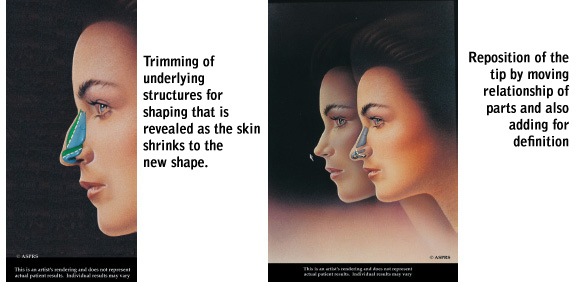Rhinoplasty
Patient Information sheet
Rhinoplasty
Rhinoplasty is performed to correct aesthetic and/or functional issues that a patient perceives with regard to their nose.
The operation plan is done in consultation with the patient and involves more than one consultation. The first consultation is charged. The subsequent planning consultation is part of the operation and not separately charged. The operation itself is all done from within the nose.
The nose is generally bruised and swollen for 3-4 days with much of the swelling subsided by 10 days. The remaining swelling takes a few weeks to subside.
BACK TO WORK
Patients are off work for a minimum of two weeks, often three, following this operation on average. Some procedures allow a quicker return to work.
COMMON OPERATION CATEGORIES
- Correction nasal deviation and obstruction
- Nasal reduction of hump and/or prominent tip
- Nasal re-shaping of tip cartilage with or without grafts
- Nasal dorsal graft to define bridgeline
- Reduction nostrils too wide or thick
- Rebalance elements of nose consistent with ethnic group
- Correction congenital deformities.
THE PRE OPERATIVE PLAN
A plan for the operation is prepared. This is generally completed at the second consultation and translated into the technicalities required. This is also an opportunity to ask further questions and to get clarity on any undefined areas. This further consultation is not charged for but is part of the operation.

OPERATION DETAILS
The operation is generally done under a general anaesthetic though it is possible to do some minor procedures under local. The operation commences with the administration of various agents to reduce both swelling and bleeding. A small incision is made at the base of the columella and extended inside the nose where the operation is performed.
There are few external incisions in this operation. The underlying bones and cartilage is reshaped according to the plan and any necessary grafts are added after careful shaping and fixed in position. In these instances the materials removed for trimming are reused for additional grafts so there is seldom any need for additional donor areas. In thin-skinned people of Celtic decent a graft of temporalis fascia may be used to thicken the skin fractionally from within to disguise any irregularities from becoming visible in the healing process.
Operations take from one and a half hours to three and a half hours depending on complexity.
At the conclusion of the operation an external splint is applied, generally a soft foam backed malleable metal one for protection. Small foam packs are placed in the nose to be removed after a day or two.
Patients are advised to not bend down, no stooping or heavy lifting and to rest at home with the head up after discharge from hospital.
POST OP
Swelling after the operation is generally reduced with the agents given but some still occurs. This is variable and the eyes may shut for a day or so. Ice packs can be used. When the splint is removed most of the swelling has gone down over the ensuing week or two.
There is however still swelling over the bridge of the nose and between the eyes for another week or so. A very subtle degree of swelling may persist within the nasal tissues particularly around the sides and tip of nose that settles over the next few months.
The new profile is obvious as soon as the splint is removed. Patients can usually breathe quite well through the nose after the first couple of weeks and the crusts separate. Breathing may take 6 to 8 weeks to return to normal, providing the patient has no pre-existing allergies which remain unchanged.
Scar activity starts after two weeks and is felt rather than seen as a thickening beneath the skin and a woody feeling. This is combined with some numbness which takes a few weeks to go. The scar resolution is complete at one year and the skin has by this time returned to normal.
REOPERATION RATE
The reoperation rate for this procedure done by a plastic surgeon is 10% pooled. For other specialists is above 20%. The reason for this is that if the cartilage curls in the healing process and may produce a visible asymmetry. A second stage if required is usually fairly short.
YOUR RESPONSIBILITIES
- To reveal all medications, conditions, history, allergies and recreational drug use.
- To understand all aspects of the information discussed at consultation and all written information given and to seek clarification if needed.
- To understand that you are entering a process where your surgeon is dedicated to the best possible outcome. This requires engaging in the complexities of biology, healing and individual differences.
- That additional stages or further surgeries are occasionally required and that the surgeons best efforts are the basis of the charges. Further surgeries will incur additional charges in pursuit of a particular result.
- To understand that the initial consultation is charged for but all subsequent pre-operative consultations pertaining to this surgery are at no charge.
- To understand and accept the above conditions.
Make an Enquiry

Reach out to Northland Plastic Surgery by phone, email or book in an assessment via Zoom.
